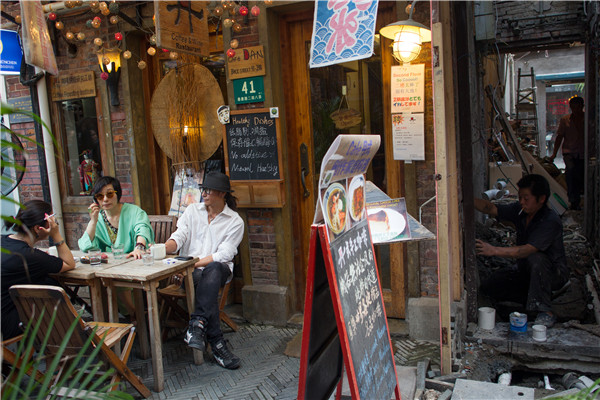 |
|
Souvenir shops, bars and cafes now outnumber art galleries and studios in Tianzifang. [Photos By Yu Ran And Gao Erqiang/China Daily] |
In 1998, Zheng kicked off the project to turn the area into a hub for the cultural industry. He leased out the 10,000-square-meter space occupied by the idle factories on a 20-year contract and moved the street market indoors.
In 1999, Chen Yifei, a world-renowned Chinese painter, and several other artists set up studios in the old factories on Lane 210 along Taikang Road, creating a cluster of more than 200 culture and art venues. This was also the time when Huang Yongyu, another well-known painter, named the area "Tianzifang" as a tribute to an ancient Chinese painter of the same name.
One year later, the sub-district government leased the remaining spaces to a sole proprietor named Wu Meisheng. Galleries, cafes and boutiques have since opened like clockwork alongside old Shanghai homes, imbuing the area with a unique charm not seen before in the city.
In 2004, Tianzifang nearly became a victim of the city's relentless modernization. Calls were made for the place to be torn down to make way for high-rise shopping malls that were part of a real estate project by Taiwan's ASE Group.
Fortunately, thanks to the intervention of Zheng and a group of his supporters, Tianzifang emerged unscathed.
According to statistics provided by Yu, 100 million square meters of old buildings in Shanghai were torn down between the early 1990s and 2008 to make way for modern ones.
However, the Shanghai government has also been striving to preserve traditional architecture, turning many old estates into zones for creative industries.
The 1933 Shanghai complex is one such example. Formerly a slaughterhouse, the place is now home to several creative agencies and design studios.
According to statistics from the municipal government, there were 87 zones hosting creative industries and 52 parks for cultural industries at the end of 2013.
Following this incident, Zheng realized that the residents from neighboring lanes needed to band together to help expand the size of Tianzifang in order to boost the significance of the area.
Renovation works were also planned to give the rustic zone a new lease of life.
"This led to a new shift from the residential to non-residential use of space in Tianzifang and the local residents were quick to join the effort," says Zheng.
Zhou Xinliang was one of the first residents to lend support. In September 2004, he leased his 33-sq-m room on Lane 210 to a fashion designer.
However, he says that he had done so only because the 3,500 yuan ($540) he charged for rent would go a long way in helping with his living expenses - he was only getting 300 yuan every month from his retirement pension.
|
|
|
|
|
|
|
|
